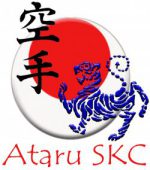Kihon – “Basic” or “Fundamental” (基本)
Kihon enables Karateka to learn and practice the fundamental techniques of Shotokan Karate in a structured manner. Most Kihon is performed in linear fashion, stepping forwards or backwards as the techniques & combination dictate.
As the level and experience of the Karateka increases, as does the complexity & degree of difficulty of the techniques they are required to do.
Kata – “Form” or “Kata” (型)
Kata is a culmination of techniques and combinations in a set form. Once again, as the level and experience of the Karateka increases, so does the complexity & difficulty of the Kata he/she will be asked to perform. Differing from Kihon, Kata are most often not linear in fashion, but more directional basing themselves on what could be classed as an ‘imaginary fight’ against multiple attackers.
Each Kata has its own underlying style. Some are strong and dynamic with a massive generation of power and robust movements as if to drive through oncoming opponents. Some are lightening quick in pace and movement as if the Karateka is attacked my multiple enemies in quick succession.
Kumite – “Joining Hands” or “Assembled Hands” (組手)
Sparring (With partner/s, usually just one)
Do not mistake Kumite for ‘fighting’. Kumite is a method, used to structure opponent based training and competition which has rules and regulations to it. A fight situation is something qute different.
From a basic level, Kumite utilises basic techniques (aggressive and defensive) to hone Karateka ‘Zanshin’ (awareness), reaction, speed, power and accuracy as well as fighting spirit.
At a higher level, free-kumite allows Karateka to utilise all techniques in their repertoire, whilst still adhering to a structure.
Bunkai – “Analysis” or “Disassembly (分解)
Bunkai is a term used in Japanese martial arts which refers to the analysis or disassembly of Kata to understand fighting techniques contained in the Kata. The extracted techniques when applied hand-to-hand are called Oyo (below).
Oyo – “Application” or “Practical Use” (応用)
Oyo is a word that refers to the self-defence application of a movement or movements in Kata.
Pad Work
Padwork is the use of training mitts or gloves and pads as the basis for a workout programmed around the use of combat skills training and techniques.
NB. In Japanese martial arts, the term for “pad work” or training with striking pads isn’t directly rooted in traditional terminology since pad work is a more modern training method. However, the closest term might be “mitt work,” which is often referred to as “mittō geiko” (ミット稽古) or simply “mittō” (ミット). “Mittō” is derived from the English word “mitt” and “geiko” (稽古) means “practice” or “training” in Japanese.
Reigi – “Etiquette” (礼儀)
Dojo Etiquette is a very important part of Karate and life as a whole. Showing respect to all, control, discipline and perseverance whether in the Dojo or not, is a fundamental principle we instill.

